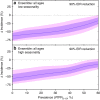Defining the relationship between infection prevalence and clinical incidence of Plasmodium falciparum malaria
- PMID: 26348689
- PMCID: PMC4569718
- DOI: 10.1038/ncomms9170
Defining the relationship between infection prevalence and clinical incidence of Plasmodium falciparum malaria
Abstract
In many countries health system data remain too weak to accurately enumerate Plasmodium falciparum malaria cases. In response, cartographic approaches have been developed that link maps of infection prevalence with mathematical relationships to predict the incidence rate of clinical malaria. Microsimulation (or 'agent-based') models represent a powerful new paradigm for defining such relationships; however, differences in model structure and calibration data mean that no consensus yet exists on the optimal form for use in disease-burden estimation. Here we develop a Bayesian statistical procedure combining functional regression-based model emulation with Markov Chain Monte Carlo sampling to calibrate three selected microsimulation models against a purpose-built data set of age-structured prevalence and incidence counts. This allows the generation of ensemble forecasts of the prevalence-incidence relationship stratified by age, transmission seasonality, treatment level and exposure history, from which we predict accelerating returns on investments in large-scale intervention campaigns as transmission and prevalence are progressively reduced.
Figures



Similar articles
-
Association between the proportion of Plasmodium falciparum and Plasmodium vivax infections detected by passive surveillance and the magnitude of the asymptomatic reservoir in the community: a pooled analysis of paired health facility and community data.Lancet Infect Dis. 2020 Aug;20(8):953-963. doi: 10.1016/S1473-3099(20)30059-1. Epub 2020 Apr 8. Lancet Infect Dis. 2020. PMID: 32277908 Free PMC article.
-
Malaria infection and severe disease risks in Africa.Science. 2021 Aug 20;373(6557):926-931. doi: 10.1126/science.abj0089. Science. 2021. PMID: 34413238 Free PMC article.
-
Relationships between the outcome of Plasmodium falciparum infection and the intensity of transmission in Africa.Am J Trop Med Hyg. 2004 Aug;71(2 Suppl):80-6. Am J Trop Med Hyg. 2004. PMID: 15331822
-
Age patterns of severe paediatric malaria and their relationship to Plasmodium falciparum transmission intensity.Malar J. 2009 Jan 7;8:4. doi: 10.1186/1475-2875-8-4. Malar J. 2009. PMID: 19128453 Free PMC article. Review.
-
Folic acid supplementation and malaria susceptibility and severity among people taking antifolate antimalarial drugs in endemic areas.Cochrane Database Syst Rev. 2022 Feb 1;2(2022):CD014217. doi: 10.1002/14651858.CD014217. Cochrane Database Syst Rev. 2022. PMID: 36321557 Free PMC article.
Cited by
-
Estimating the burden of dengue and the impact of release of wMel Wolbachia-infected mosquitoes in Indonesia: a modelling study.BMC Med. 2019 Sep 9;17(1):172. doi: 10.1186/s12916-019-1396-4. BMC Med. 2019. PMID: 31495336 Free PMC article.
-
Malaria risk in young male travellers but local transmission persists: a case-control study in low transmission Namibia.Malar J. 2017 Feb 10;16(1):70. doi: 10.1186/s12936-017-1719-x. Malar J. 2017. PMID: 28187770 Free PMC article.
-
Indirect effects of the COVID-19 pandemic on malaria intervention coverage, morbidity, and mortality in Africa: a geospatial modelling analysis.Lancet Infect Dis. 2021 Jan;21(1):59-69. doi: 10.1016/S1473-3099(20)30700-3. Epub 2020 Sep 21. Lancet Infect Dis. 2021. PMID: 32971006 Free PMC article.
-
The contribution of non-malarial febrile illness co-infections to Plasmodium falciparum case counts in health facilities in sub-Saharan Africa.Malar J. 2019 Jun 11;18(1):195. doi: 10.1186/s12936-019-2830-y. Malar J. 2019. PMID: 31186004 Free PMC article.
-
Incorporating Stage-Specific Drug Action into Pharmacological Modeling of Antimalarial Drug Treatment.Antimicrob Agents Chemother. 2016 Apr 22;60(5):2747-56. doi: 10.1128/AAC.01172-15. Print 2016 May. Antimicrob Agents Chemother. 2016. PMID: 26902760 Free PMC article.
References
-
- World Health Organisation. World Malaria Report 1-227 WHO, Switzerland (2014).
-
- Craig M. H., Snow R. W. & le Sueur D. A climate-based distribution model of malaria transmission in sub-Saharan Africa. Parasitol. Today 15, 105–111 (1999). - PubMed
Publication types
MeSH terms
Grants and funding
LinkOut - more resources
Full Text Sources
Other Literature Sources

